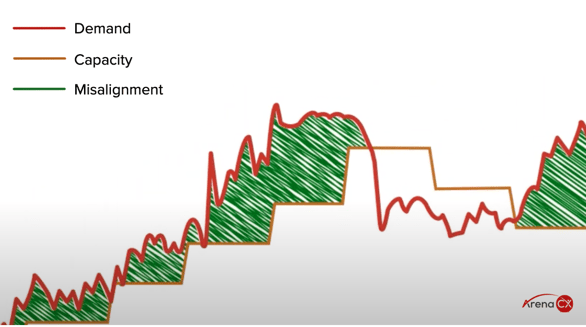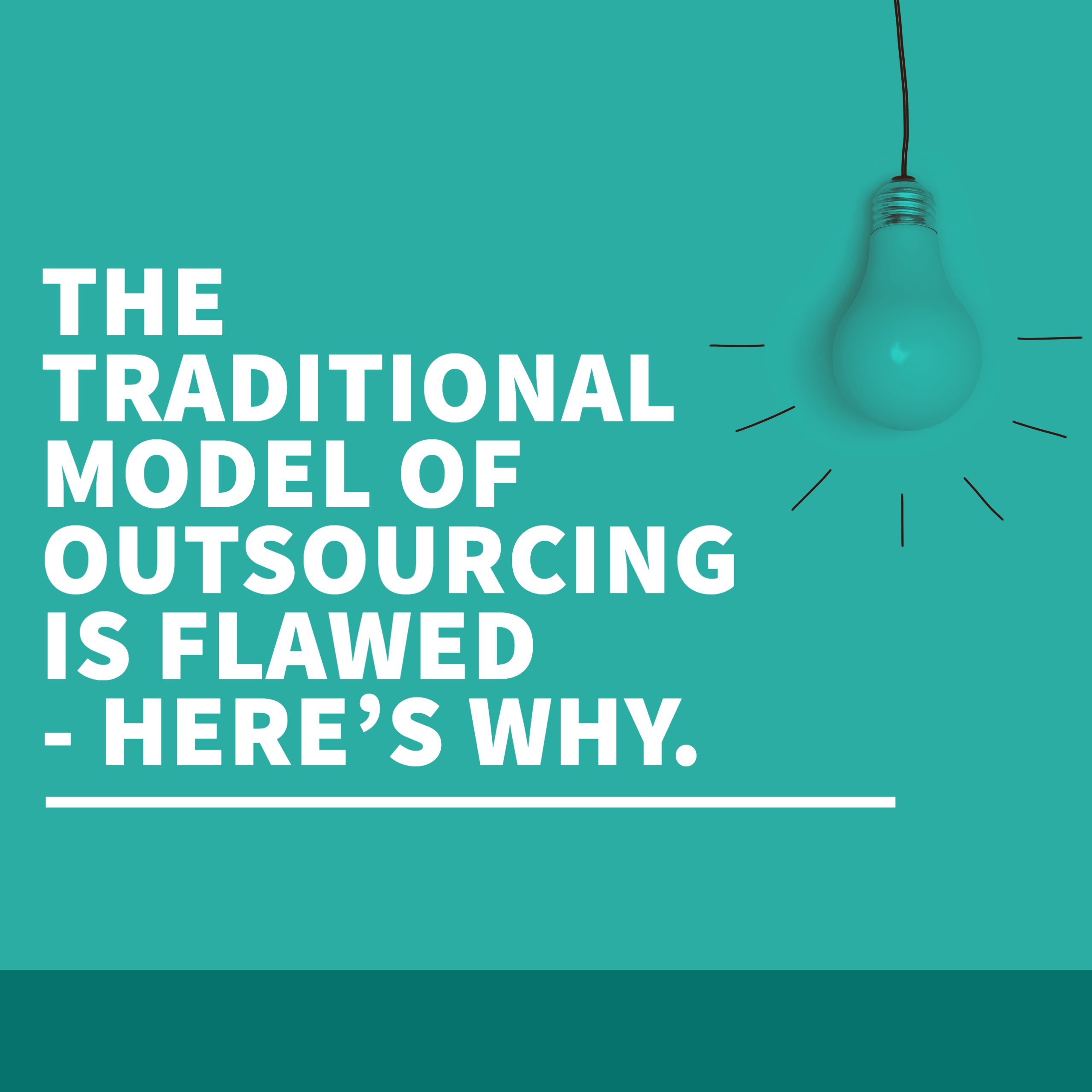As a company focused on outsourcing, it’s clear we believe that outsourcing has the potential to make many operator’s lives simpler, while saving a business significant time and money. And, in many cases, it already does – but not without a huge front load of work and a lot of day-to-day maintenance.
If you’re currently outsourcing, you might relate to some of these frustrations: paying too much for unneeded agents when demand ebbs, suffering through backlogs when your volume is higher than anticipated, long RFP-processes when it’s time to hire a new contact center, long contracts that don’t always meet your needs – the list goes on!
As industry veterans, our team finally said “enough” and put our determination to work to figure out how we could combat these daily struggles outsourcers are facing. For something that is supposed to save time and money, the process of vetting, selecting, and onboarding partners can be a major burden and because of that, something many companies avoid, costing them long-term operational efficiency.
On our journey to creating a more efficient and sustainable outsourcing process that results in tangible outcomes, we first identified the 5 biggest challenges we, and other outsourcers, were regularly facing.
These Challenges Include:
Why the traditional model is flawed.
Nearly all contact centers operate on a per hour/per head pricing model.
So why doesn’t this model work? Demand ebbs and flows. While most companies have a fine-tuned method for forecasting support interactions, there is always the potential for the unexpected.
For example, imagine a phone company experiences a service interruption in a densely populated area and their support interactions increase 3x their normal amount. This is a critical moment for them – customers are angry because they lost service, then when they call support they become even angrier when they’re left on hold for an hour.
This leads to a major churn event because customers did not get the support they needed when they needed it the most.
You might think, if a company is outsourcing they can just call in more agents to help, right? Unfortunately, that isn’t usually how typical contact center contracts work.
Because you agree to a specific amount of needed agents as determined by the forecast you share with your partner, you are essentially paying for that set amount of agents and the hours those agents work.
If your BPO partner happens to have additional agents available at your time of need you may be able to snag extra help, but chances are you’re out of luck. Your forecast did not predict the influx so your contact center partner likely would not have staffed additional agents.
This concept holds true from the other end as well. Often, operators find themselves paying for agents they don’t need because their demand was over-forecasted.
For example, imagine your company was anticipating the launch of a new product this month so you reflected the increase in support interactions within your demand plan. At the last minute a bug was detected and the launch was halted and pushed to next month. Now your elevated forecast is no longer relevant and you and your company are stuck wasting thousands of dollars on agents who don’t have tickets to work.
This concept can be seen in the chart below where businesses experience higher service demand than agent capacity, and by the time capacity catches up, demand is always one-step ahead resulting in too many workers and not enough work.

In either scenario, your business is not operating as efficiently as if it were run on a better outsourcing model.
Challenge 2:
The misaligned interests between the brand and the contact center, with little recourse for poor performance.
The sad truth: your business isn’t as important to your contact center as it is to you. And why should it be? They’re running their business just as you’re running yours.
If your contact center partner is paid per hour then they have fixed margins: they pay their employees $X/hour and charge you $X+Y/hour. They will make $Y every hour regardless of how many tickets their agents work or chats they answer.
You, as the business leader, want your customers responded to as quickly as possible, answering as many inquiries as possible each day.

Yet, what incentive is there for your contact center to improve their efficiency? If anything, they may be incentivized to work slower, answering less tickets than they could, so that you feel the need to sign a bigger contract for more agents in the future.
Similarly, you want your customers to receive top-notch customer service. However, the standard BPO contract does not incorporate bonuses or consequences for great or poor performance so there is little incentive for your partner to do more than meeting your bare minimum needs.
So, what do you do when your partner starts underperforming leaving you with low CSAT and NPS? Sadly, there isn’t much you can do. You can try holding goal alignment meetings, but ultimately if your partner does not improve there isn’t much you can do except wait out your contract, which leads us to our third outsourcing challenge: long, sticky contracts.
Challenge 3:
Long term contracts that keep businesses tied to poor contact center partners.

Quite simply, once the pen hits the paper, you’re stuck. BPO partnerships are generally contracted for at least one to two years, whether the partner is meeting your needs or not.
This leaves you with very few options: find an additional partner and sign another long contract that puts you in the same vulnerable position, or wait it out until your contract ends, suffering through your partner’s less-than-desired performance. Personally, we don’t think either option is sufficient.
Pro tip: To protect your business from the risk of a given partner’s poor performance, we recommend engaging with more than one contact center partner at a time. Read more about the benefits of taking a portfolio approach to outsourcing.
Challenge 4:
The inability to scale quickly and effortlessly when the need for additional agents arises.
As described above, you’re typically held to the forecast you provide to your partner. Your contact center uses your forecast to recruit and staff agents to work your business.
This makes sense for your partner, but leaves you high and dry if your ticket volume surpasses expectations.
For the operator, this can result in ‘fire drills’ internally where staff from other departments are recruited to help clear the queues.
Unfortunately, while you’re grateful to have willing team members, it also means other operational tasks across the organization are being put on hold until your backlog of tickets is cleared. Could your business afford to keep doing this?
You should be able to get access to agents when you need them.
Unexpected events happen, and being able to quickly pivot is essential to running an effective support organization, which is why we consider the rigidity in agent access one of our top challenges with the current outsourcing model.
Challenge 5:
The long, inefficient partner selection and RFP-processes.
If you’ve outsourced before, or are currently outsourcing, you’re probably all too familiar with the partner selection process known as RFPs.
Requests for Proposals (RFPs) are the subject of many operators’ nightmares – they’re long, daunting, and incredibly cumbersome and time-consuming for individuals on both the requester and provider end.
Yet, they’re the norm in the traditional outsourcing model and, in order to win business, a BPO has to participate to be taken seriously. The problem we have is that these processes are long, wasting months of valuable company time and money.
The other issue with the partner selection process is that brands – especially those new to the outsourcing game – can find themselves swayed by the pretty powerpoints and convincing salespeople who know exactly the right thing to say to someone who is looking for their service.
Call centers with the flashiest displays and most beautifully crafted marketing materials may win the deal, even if they don’t have the best service for a brand’s specific needs. This “beauty pageant” mentality is cause for concern when, as previously mentioned, once the contract is signed you’re stuck with that partner for a year or two, even if they’re not the right one for your business.
ArenaCX is changing the game.
You’ve read our biggest challenges with the traditional model, and now, we’re here to tell you there’s a better way. Through trial and implementation, we’ve discovered the winning ingredients to mitigate these day-to-day outsourcing challenges and present a new, more effective, BP(2.)O* solution.
Pricing based on interactions actually worked.
We’ve re-imagined the outsourcing model so you only pay for the tickets worked and not by-the-head for agents you’re not always using.
This means you save money when your ticket volume ebbs.
It also means your partner is incentivized to work your tickets efficiently, so that they can answer (and be paid) for as many of your interactions as possible. Employing this model means that the number of agents working tickets on your behalf will likely fluctuate over time, as you have seasonal peaks and lulls on the back of natural growth.
This means you will likely have more agents trained to handle your business than you may necessarily need. The benefit is that these agents may be able to serve as flex capacity in the event your volume surpasses your forecast.
Put simply, your contact center partner(s) get more business (more money), while you get on-demand access to staffing at a fairer price. It’s a win-win!
Solution 2:
Your contact center’s incentives are aligned with yours.
ArenaCX is introducing the concept of healthy competition to the BPO industry.
While historically there has been little a brand could do to help improve the performance of underperforming partners, with the introduction of competition, contact centers are motivated to perform their best.
Watch this video about how ArenaCX’s performance incentives works.

If a given partner is performing better than its peers, it will receive more tickets of that type: a win for you, your customer, and the partner. Because your partners are paid per ticket worked, they are incentivized to work harder to keep receiving a larger share of your customer interactions, which results in more business – and money – for them.
Solution 3:
Easily test and trial new BPO partners.
We don’t believe in a set-it-and-forget-it approach. Your business is unique and constantly evolving. Your partnerships must as well.
Based on the needs of your business, ArenaCX will put together a portfolio of contact centers who we believe will meet your needs (and exceed your expectations). If for whatever reason, one of the partners we recommend is not a good fit or your business evolves and they are no longer serving your needs, you can easily swap them for another BPO.
With ArenaCX, you can test and trial other partners in the network with ease until you find the
right one(s) for your business. No long-term contracts or commitments required.
Scale up or down with ease.
Because we have an entire network (one that continues to grow) of partners, you have access to agents on-demand, no matter what unexpected event causes an abrupt change in your forecast.
With our smart routing solution, the tickets in your network are automatically sent to your partners who have available capacity, with more partners easily ready-to-onboard in moments of need. No more internal fire drills to clear queues – it’s all handled with ease through the ArenaCX network and smart routing solution.
And, of course, when your backlog clears, your tickets continue to route normally to your trusted partners, no commitments to keeping on additional agents who helped during crunch time.
Solution 5:
A streamlined, quick engagement process (versus long RFP).
In order to join the marketplace, each buyer and seller of outsourcing services must agree to a universal, balanced set of terms. This allows us to conduct an extremely efficient, mini-RFP process when matching brands with the right partners.
As a result of not having a long, drawn out RFP process, brands can test and trial new partners quickly and easily.
So, there you have it. BP(2.)O.
It’s outsourcing made simple and easy by eliminating all the elements we hate about the traditional outsourcing model.
We’d love to talk to you more about how ArenaCX could fit seamlessly into your support operations to help save you time, energy, and money while creating operational resiliency.
Interested in learning more about how ArenaCX can help you break out of the outsourcing status quo?
*Pronounced BP two do oh and is a term coined by the ArenaCX team to imply we’re business process outsourcing reimagined. Don’t just BPO, BP(2.)O.
Related Articles
Want more? Here are some other blog posts, topics and articles you might be interested in.












